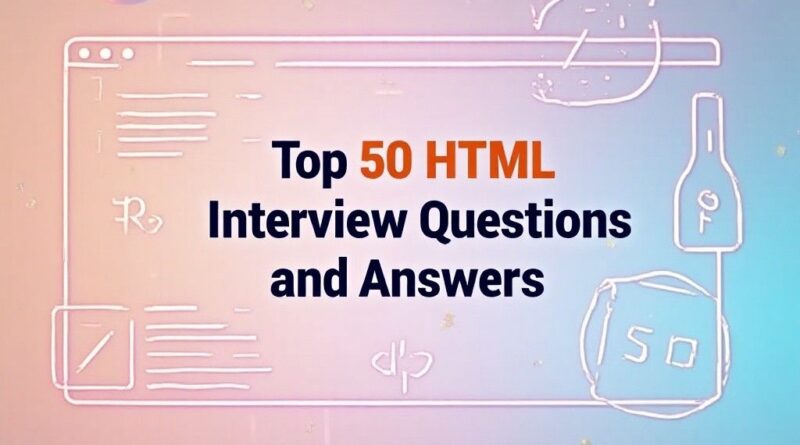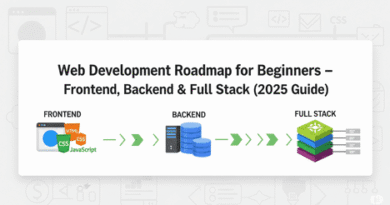Top 50 HTML Interview Questions and Answers
🔝 Top 50 Most Important HTML Interview Questions and Answers
💡 Introduction
HTML (HyperText Markup Language) is the foundational language for creating web pages. Whether you’re applying for a front-end developer, full-stack engineer, or UI/UX position, HTML is always a core topic in technical interviews. In this article, I’ve compiled the top 50 most commonly asked HTML interview questions with answers to help you ace your interviews.
Let’s dive right in 👇
1. What is HTML?
Answer:
HTML stands for HyperText Markup Language. It is the standard language used to create web pages. HTML describes the structure of a webpage using elements represented by tags.
Example:
2. What is the latest version of HTML?
Answer:
The latest official version of HTML is HTML5. It introduced several new elements, attributes, and APIs for modern web applications like <video>, <audio>, <canvas>, etc.
3. What are HTML tags?
Answer:
HTML tags are keywords enclosed within angle brackets. Tags tell the browser how to display content.
Example:<p>This is a paragraph.</p>
4. What is the difference between HTML and HTML5?
Answer:
| Feature | HTML | HTML5 |
|---|---|---|
| Multimedia Support | Limited | Enhanced (<audio>, <video>) |
| Doctype | Complex | Simplified <!DOCTYPE html> |
| Semantic Tags | Fewer | More semantic tags (<article>, <section>, etc.) |
5. What is a semantic tag in HTML5?
Answer:
Semantic tags describe the meaning of the content, improving readability and SEO.
Examples:<article>, <section>, <nav>, <header>, <footer>
6. What is the use of the <DOCTYPE> declaration?
Answer:
It tells the browser what HTML version the document is using. It must be the very first line in HTML documents.
HTML5 Syntax:<!DOCTYPE html>
7. What are void elements in HTML?
Answer:
Void elements are self-closing tags that do not require a closing tag.
Examples:<br>, <hr>, <img>, <input>
8. What is the difference between <div> and <span>?
Answer:
-
<div>is a block-level element used for grouping larger sections. -
<span>is an inline element used for styling small chunks.
Example:
9. What is the difference between id and class attributes?
Answer:
-
idis unique to a single element. -
classcan be used with multiple elements.
Example:
10. How do you insert an image in HTML?
Answer:
Use the <img> tag with src and alt attributes.
11. What is the difference between <ol>, <ul>, and <dl>?
Answer:
-
<ol>: Ordered List -
<ul>: Unordered List -
<dl>: Definition List
12. What are the new input types in HTML5?
Answer:
HTML5 introduced:
-
email -
date -
url -
range -
search -
color
13. What are global attributes in HTML?
Answer:
These can be used on any HTML element.
Examples:class, id, style, title, data-*
14. What is the purpose of the <meta> tag?
Answer:
It provides metadata about the HTML document, like charset, viewport settings, SEO keywords, etc.
15. Explain the difference between <head> and <body> tags.
Answer:
-
<head>contains meta-information (title, links, scripts). -
<body>contains the visible content of the page.
16. How do you create a hyperlink in HTML?
Answer:
Use the <a> tag.
Example:
17. What is the use of the alt attribute in images?
Answer:
Provides alternative text for screen readers and when the image can’t load.
18. Can you nest one HTML element inside another?
Answer:
Yes, HTML allows nesting.
Example:
19. What is the <iframe> tag?
Answer:
Used to embed another HTML page within the current page.
Example:
20. What is the difference between relative and absolute URLs?
Answer:
-
Relative: Based on current page location.
-
Absolute: Complete path including domain.
21. What is a favicon and how is it added?
Answer:
A small icon shown in the browser tab.
Example:
22. What are data- attributes in HTML5?*
Answer:
Custom data attributes used to store extra information.
Example:
23. How can you make a text input required?
Answer:
Add the required attribute.
Example:
24. How do you open a link in a new tab?
Answer:
Use target="_blank" in the anchor tag.
Also Read,
Top 50 Most Important Java Interview Questions and Answers
Mastering JavaScript: From Absolute Beginner to Advanced Developer
25. What is the difference between <strong> and <b>?
Answer:
-
<strong>has semantic meaning (importance). -
<b>is only for styling (bold).
26. What is the <canvas> element in HTML5?
Answer:
The <canvas> element is used to draw graphics on a web page via JavaScript.
Example:
27. What is the purpose of the <label> tag in forms?
Answer:
It defines a label for <input> elements, improving accessibility and user experience.
Example:
28. What are block-level and inline elements?
Answer:
-
Block-level elements: Start on a new line and take full width. Example:
<div>,<p>,<h1>. -
Inline elements: Do not start on a new line. Example:
<span>,<a>,<strong>.
29. What is the use of <fieldset> and <legend>?
Answer:
Used to group related elements in a form.
Example:
30. How do you add comments in HTML?
Answer:
Use <!-- comment here -->
31. What is HTML Entity?
Answer:
A way to display reserved characters using special codes.
Example:< = <, > = >, & = &
32. What is the <noscript> tag used for?
Answer:
Displays alternative content for users who have disabled JavaScript.
Example:
33. What are deprecated tags?
Answer:
Tags no longer recommended in HTML5.
Examples:<center>, <font>, <big>
34. What are the accessibility features of HTML?
Answer:
HTML supports accessibility using:
-
ARIA roles
-
Semantic elements
-
altattributes for images -
Keyboard navigation
35. How do you add a background image using HTML only?
Answer:
You should use CSS for that, but inline styles are possible.
Example:
36. What is the difference between <script> and <noscript>?
Answer:
-
<script>: Contains JavaScript. -
<noscript>: Fallback content if JS is disabled.
37. What is a placeholder attribute?
Answer:
Displays a short hint in an input field.
Example:
38. How to disable an HTML form element?
Answer:
Use the disabled attribute.
Example:
39. What is the difference between readonly and disabled?
Answer:
-
readonly: User can’t change value but data is submitted. -
disabled: Field is not editable and not submitted.
40. How do you group radio buttons in a form?
Answer:
By giving them the same name attribute.
Example:
41. What is the <template> tag?
Answer:
Used to hold hidden content that can be activated with JavaScript.
Example:
42. What is lazy loading in HTML5?
Answer:
Delays loading of images until they are in the viewport.
Example:
43. How do you create a dropdown list in HTML?
Answer:
44. How can you auto-focus an input field?
Answer:
Use the autofocus attribute.
Example:
45. What is the enctype attribute used for in forms?
Answer:
Specifies the encoding type of form data when submitting.
Example:multipart/form-data is used for file uploads.
46. What is the difference between span and label?
Answer:
-
<span>: Generic inline container. -
<label>: Specifically for form inputs.
47. How to include external CSS and JS files?
Answer:
48. What is the difference between synchronous and asynchronous script loading?
Answer:
-
async: Loads in parallel with HTML parsing. -
defer: Executes after HTML parsing.
Example:
49. What is Cross-Origin Resource Sharing (CORS) in HTML context?
Answer:
CORS allows a webpage to access resources from another domain, subject to browser security restrictions. Managed via server headers, not HTML directly.
50. How do you improve the SEO of an HTML page?
Answer:
-
Use semantic tags
-
Add meta tags (title, description, keywords)
-
Use proper heading tags (
<h1>to<h6>) -
Add alt text for images
-
Optimize loading time
🎯 Conclusion
Understanding these 50 commonly asked HTML interview questions and answers will prepare you thoroughly for web development interviews. Whether you’re a fresher or have a few years of experience, mastering these concepts boosts your confidence and demonstrates professionalism to interviewers.
📤 Stay Updated with NextGen Careers Hub
📱 Follow us on Instagram
📺 Subscribe us on YouTube
Please share our website with others: NextGenCareersHub.in





